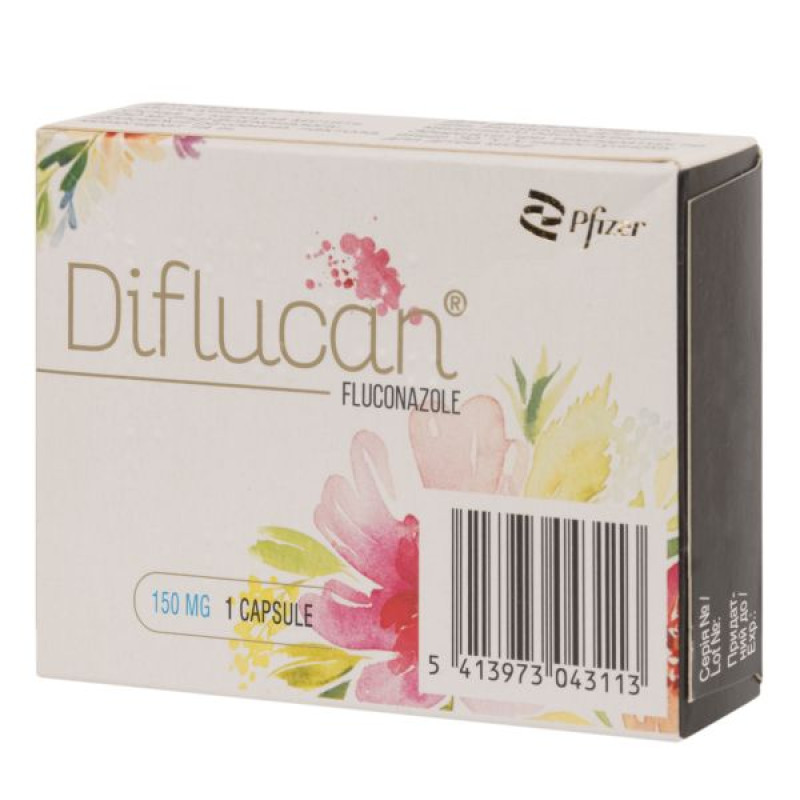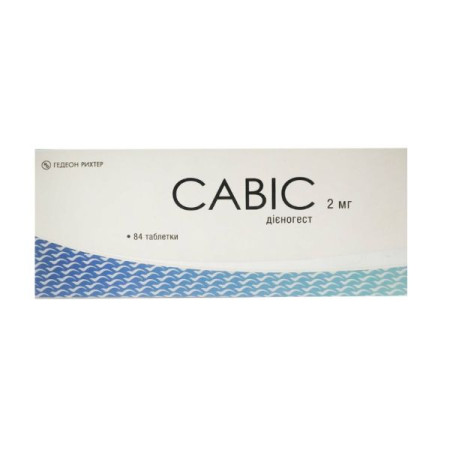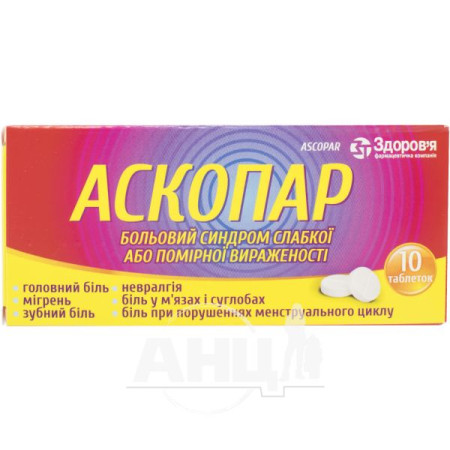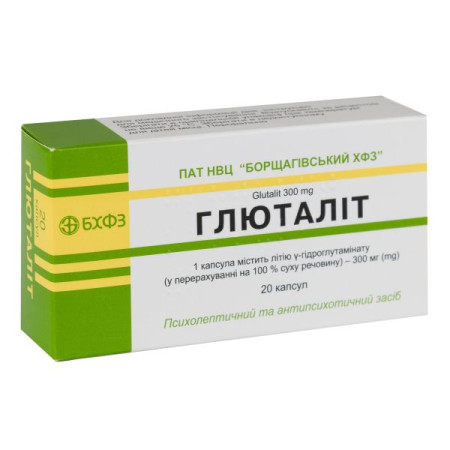Diflucan capsules 150 mg blister No. 1
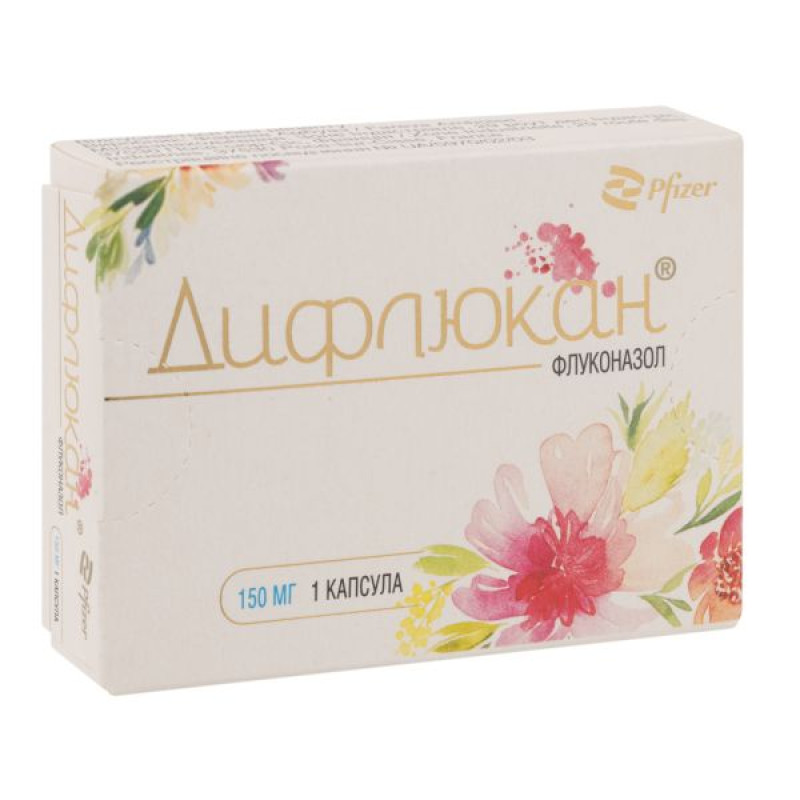
Instructions Diflucan capsules 150 mg blister No. 1
Composition
active ingredient: fluconazole;
1 capsule contains 150 mg of fluconazole;
Excipients: lactose monohydrate; corn starch; sodium lauryl sulfate; magnesium stearate; colloidal anhydrous silicon dioxide.
Dosage form
Capsules.
Main physicochemical properties: hard opaque gelatin capsules (capsule size No. 1) containing white powder, with a light turquoise-blue cap and body, with the Pfizer logo and the inscription FLU-150 printed in black ink.
Pharmacotherapeutic group
Antifungal agents for systemic use. Triazole derivatives. ATX code J02A C01.
Pharmacological properties
Pharmacodynamics
Mechanism of action
Fluconazole is an antifungal agent of the triazole class. Its primary mechanism of action is inhibition of fungal cytochrome P450-mediated 14-alpha-lanosterol demethylation, an essential step in fungal ergosterol biosynthesis. Accumulation of 14-alpha-methyl sterols correlates with subsequent loss of ergosterol from the fungal cell membrane and may be responsible for the antifungal activity of fluconazole. Fluconazole is more selective for fungal cytochrome P450 enzymes than for various mammalian cytochrome P450 enzyme systems.
Fluconazole 50 mg daily for 28 days had no effect on plasma testosterone levels in men or on endogenous steroid levels in women of reproductive age. Fluconazole 200-400 mg daily had no clinically significant effect on endogenous steroid levels or on the response to adrenocorticotropic hormone (ACTH) stimulation in healthy male volunteers.
Interaction studies with antipyrine have shown that single or repeated administration of 50 mg fluconazole does not affect the metabolism of antipyrine.
In vitro sensitivity
Fluconazole has demonstrated antifungal activity in vitro against the most common Candida species (including C. albicans, C. parapsilosis, C. tropicalis). C. glabrata exhibits a wide range of susceptibility to fluconazole, while C. krusei is resistant to it.
Fluconazole also demonstrates in vitro activity against Cryptococcus neoformans and Cryptococcus gattii, as well as against the endemic mold fungi Blastomices dermatitidis, Coccidioides immitis, Histoplasma capsulatum, and Paracoccidioides brasiliensis.
Relationship between pharmacokinetic and pharmacodynamic properties
According to the results of animal studies, there is a correlation between the minimum inhibitory concentration and the efficacy against experimental models of mycoses caused by Candida species. According to the results of clinical studies, there is a linear relationship between the AUC and the dose of fluconazole (approximately 1:1). There is also a direct but insufficient relationship between the AUC or dose and a positive clinical response to the treatment of oral candidiasis and, to a lesser extent, candidemia. Similarly, the treatment of infections caused by strains for which fluconazole shows a high minimum inhibitory concentration is less satisfactory.
Mechanism of resistance
Candida species exhibit multiple mechanisms of resistance to azole antifungal agents. Fluconazole exhibits high minimum inhibitory concentrations against fungal strains that possess one or more mechanisms of resistance, which negatively affects efficacy in vivo and in clinical practice. Superinfection with Candida spp., other than C. albicans, which are often insensitive to fluconazole (e.g. Candida krusei), has been reported. Alternative antifungal agents should be used in such cases.
Breakpoints (according to the recommendations of the European Committee for Antimicrobial Susceptibility Testing).
Based on a review of pharmacokinetic/pharmacodynamic information, in vitro susceptibility and clinical response, breakpoints for fluconazole have been established for Candida species. These have been divided into non-species specific breakpoints, which are largely based on pharmacokinetic/pharmacodynamic information and are not dependent on species-specific MICs, and species-specific breakpoints, which are most commonly associated with human infections. These breakpoints are listed below.
| Antifungal agent | Control points associated with a certain type S ≤ / R > | Control points not associated with a specific species S ≤ / R > | ||||
| Candida albicans | Candida glabrata | Candida krusei | Candida parapsilosis | Candida tropicalis | ||
| Fluconazole | 2/4 | IE | -- | 2/4 | 2/4 | 2/4 |
S = sensitive;
R = resistant;
a – non-species-specific breakpoints, which were determined largely on the basis of pharmacokinetic/pharmacodynamic information and do not depend on the distribution into specific species by minimum inhibitory concentration. They were studied only in microorganisms for which there is no specific breakpoint;
-- susceptibility testing is not recommended, as this species is not the target of drug therapy;
IE – there is insufficient evidence to support this species as a target for drug therapy.
Pharmacokinetics
Absorption
Fluconazole is well absorbed after oral administration, and plasma levels and systemic bioavailability exceed 90% of those achieved after intravenous administration. Concomitant food intake does not affect oral absorption. Peak plasma concentrations are achieved 0.5–1.5 hours after administration on an empty stomach. Plasma concentrations are dose-proportional. Steady-state concentrations of 90% are achieved by day 4–5 of multiple once-daily dosing. Steady-state concentrations of 90% are achieved by day 2 of treatment with a loading dose of twice the usual daily dose.
Distribution
The volume of distribution is approximately equal to the total body fluid content. Plasma protein binding is low (11–12%).
Fluconazole penetrates well into all studied body fluids. Fluconazole levels in saliva and sputum are similar to plasma concentrations. In patients with fungal meningitis, fluconazole levels in cerebrospinal fluid reach 80% of plasma concentrations.
High concentrations of fluconazole in the skin, exceeding serum levels, are achieved in the stratum corneum, epidermis, dermis and sweat. Fluconazole accumulates in the stratum corneum. When a dose of 50 mg is used once a day, the concentration of fluconazole after 12 days of treatment was 73 μg/g, and 7 days after the end of treatment, the concentration was still 5.8 μg/g. When a dose of 150 mg is used once a week, the concentration of fluconazole on the 7th day of treatment was 23.4 μg/g; 7 days after the next dose, the concentration was still 7.1 μg/g.
The concentration of fluconazole in nails after 4 months of 150 mg once weekly was 4.05 μg/g in healthy volunteers and 1.8 μg/g in nail diseases; fluconazole was detected in nail samples 6 months after the end of therapy.
Biotransformation
Fluconazole is metabolized to a small extent. When a dose labeled with radioactive isotopes is administered, only 11% of fluconazole is excreted unchanged in the urine. Fluconazole is a moderate inhibitor of CYP2C9 and CYP3A4 isoenzymes, as well as a potent inhibitor of CYP2C19 isoenzyme.
Breeding
The plasma half-life of fluconazole is approximately 30 hours. The majority of the drug is excreted by the kidneys, with 80% of the administered dose being excreted unchanged in the urine. Fluconazole clearance is proportional to creatinine clearance. No circulating metabolites have been identified.
The long half-life of the drug from blood plasma allows for a single use of the drug for vaginal candidiasis, as well as the use of the drug once a week for other indications.
Kidney failure
In patients with severe renal insufficiency (glomerular filtration rate < 20 ml/min), the half-life increases from 30 hours to 98 hours. Therefore, this category of patients requires a reduced dose of fluconazole. Fluconazole is removed by hemodialysis and, to a lesser extent, by intraperitoneal dialysis. A 3-hour hemodialysis session reduces the plasma level of fluconazole by approximately 50%.
Lactation
Fluconazole plasma and breast milk concentrations were evaluated in a pharmacokinetic study in ten lactating women who had temporarily or permanently discontinued breast-feeding their infants for 48 hours after a single 150 mg dose of Diflucan. Fluconazole was found in breast milk at a mean concentration approximately 98% of that observed in maternal plasma. The mean peak breast milk concentration was 2.61 mg/L 5.2 hours after dosing. The daily dose of fluconazole received by the infant from breast milk (assuming an average milk intake of 150 ml/kg/day), calculated based on the average peak milk concentration of 0.39 mg/kg/day, is approximately 40% of the dose recommended for newborns (< 2 weeks of age) or 13% of the dose recommended for infants for the treatment of mucosal candidiasis.
Children
Pharmacokinetic data were evaluated in 113 children in 5 studies: 2 single-dose studies, 2 multiple-dose studies, and 1 study in premature infants.
Experience with fluconazole in neonates is limited to pharmacokinetic studies in 12 premature infants with a gestational age of approximately 28 weeks. The mean age at first dose was 24 hours (range 9 to 36 hours); the mean birth weight was 900 g (range 750 to 1100 g). Seven patients completed the study protocol. A maximum of 5 intravenous injections of fluconazole at a dose of 6 mg/kg were administered every 72 hours. The mean half-life was 74 hours (44–185) on the first day, then decreased to 53 hours (30–131) on the 7th day and to 47 (27–68) on the 13th day. The area under the curve (μg*h/mL) was 271 (173–385) on day 1, increased to 490 (292–734) on day 7, then decreased to 360 (167–566) on day 13. The volume of distribution (mL/kg) was 1183 (1070–1470) on day 1, increased to 1184 (510–2130) on day 7, and to 1328 (1040–1680) on day 13.
Elderly patients
A pharmacokinetic study was conducted in 22 patients (aged 65 years and older) who received 50 mg of fluconazole orally. 10 patients were taking diuretics at the same time. Cmax was 1.54 μg/ml and was reached within 1.3 hours after fluconazole administration. The mean AUC was 76.4±20.3 μg*h/ml. The mean elimination half-life was 46.2 hours. These pharmacokinetic parameters are higher compared to those in healthy young volunteers. Concomitant use of diuretics had no significant effect on Cmax and AUC. Also, creatinine clearance (74 mL/min), the percentage of fluconazole excreted unchanged in urine (0–24 hours, 22%), and renal clearance of fluconazole (0.124 mL/min/kg) in patients of this age group were lower than those in younger volunteers. Therefore, changes in pharmacokinetics in elderly patients are clearly dependent on renal function parameters.
Indication
Diflucan® is indicated for the treatment of the following fungal infections in adults (see section "Pharmacodynamics"):
Acute vaginal candidiasis when topical therapy is not appropriate.
Candidal balanitis when topical therapy is not appropriate.
Diflucan® therapy may be initiated prior to the results of culture and other laboratory tests; however, once the results are available, anti-infective therapy should be adjusted accordingly.
Official recommendations for the appropriate use of antifungal agents should be considered.
Contraindication
Hypersensitivity to fluconazole, other azole compounds or to any of the excipients listed in the "Composition" section; simultaneous use of fluconazole and terfenadine in patients who use fluconazole multiple times at doses of 400 mg/day and above (according to the results of a multiple-dose interaction study);
Concomitant use of fluconazole and other drugs that prolong the QT interval and are metabolized by the CYP3A4 enzyme (e.g. cisapride, astemizole, pimozide, quinidine and erythromycin) (see sections "Special warnings and precautions for use" and "Interaction with other medicinal products and other types of interactions").
Interaction with other medicinal products and other types of interactions
The concomitant use of fluconazole and the following drugs is contraindicated:
Cisapride: Cardiac adverse reactions, including torsades de pointes, have been reported in patients receiving fluconazole and cisapride concomitantly. A controlled study demonstrated that concomitant administration of 200 mg of fluconazole once daily and 20 mg of cisapride four times daily resulted in significant increases in plasma cisapride levels and prolongation of the QT interval. Concomitant use of fluconazole and cisapride is contraindicated (see section 4.3).
Terfenadine: Due to cases of serious cardiac arrhythmias caused by QTc prolongation, drug-drug interaction studies have been conducted in patients receiving azole antifungals concomitantly with terfenadine. One study with fluconazole 200 mg/day did not show any QTc prolongation. Another study with fluconazole 400 mg/day and 800 mg/day showed that fluconazole at doses of 400 mg/day or higher significantly increased plasma levels of terfenadine when these drugs were administered concomitantly. Concomitant use of fluconazole at doses of 400 mg/day or higher with terfenadine is contraindicated (see section 4.3). When fluconazole is administered concomitantly with terfenadine at doses below 400 mg/day, the patient should be closely monitored.
Pimozide and quinidine: Concomitant use of fluconazole and pimozide or quinidine may result in inhibition of the metabolism of pimozide or quinidine, although no in vitro or in vivo studies have been conducted. Increased plasma concentrations of pimozide or quinidine may prolong the QT interval and, in rare cases, lead to the development of paroxysmal torsades de pointes. Concomitant use of fluconazole and pimozide or quinidine is contraindicated (see section 4.3).
Erythromycin: Concomitant use of erythromycin and fluconazole may increase the risk of cardiotoxicity (QT prolongation, torsades de pointes) and, as a consequence, sudden cardiac death. The combination of these medicinal products is contraindicated (see section 4.3).
The concomitant use of fluconazole and the following medicines is not recommended:
Halofantrine: Fluconazole may increase plasma concentrations of halofantrine due to inhibition of CYP3A4. Concomitant use of these medicinal products may increase the risk of cardiotoxicity (QT prolongation, torsades de pointes) and, consequently, sudden cardiac death. The combination of these medicinal products should be avoided (see section 4.4).
The concomitant use of fluconazole and the following drugs requires caution.
Amiodarone: Concomitant use of fluconazole with amiodarone may prolong the QT interval. Fluconazole should be used with caution with amiodarone, especially when high doses of fluconazole (800 mg) are prescribed.
Concomitant use of fluconazole and the following drugs requires caution and dose adjustment.
Effects of other drugs on fluconazole
Interaction studies have shown that oral administration of fluconazole with food, cimetidine, antacids, or subsequent total body irradiation for bone marrow transplantation has no clinically significant effect on the absorption of fluconazole.
Rifampicin: Concomitant administration of fluconazole and rifampicin resulted in a 25% decrease in AUC and a 20% decrease in the half-life of fluconazole. Therefore, an increase in the dose of fluconazole should be considered in patients taking rifampicin.
Hydrochlorothiazide: In a pharmacokinetic interaction study, co-administration of multiple hydrochlorothiazide to healthy volunteers receiving fluconazole increased the plasma concentrations of fluconazole by 40%. These interaction parameters do not require changes in the dosing regimen of fluconazole in patients receiving concomitant diuretics.
Effect of fluconazole on other drugs
Fluconazole is a moderate inhibitor of cytochrome P450 (CYP) isoenzymes 2C9 and 3A4. Fluconazole is a potent inhibitor of the CYP2C19 isoenzyme. In addition to the observed/documented interactions described below, there is a risk of increased plasma concentrations of other compounds metabolized by CYP2C9, CYP2C19 and CYP3A4 when co-administered with fluconazole. Therefore, such combinations should be used with caution; patients should be closely monitored. The inhibitory effect of fluconazole on enzymes persists for 4-5 days after administration due to its long half-life (see section "Contraindications").
Alfentanil: Co-administration of alfentanil 20 mcg/kg and fluconazole 400 mg in healthy volunteers resulted in a two-fold increase in AUC10, possibly due to inhibition of CYP3A4. Dose adjustment of alfentanil may be necessary.
Amitriptyline, nortriptyline: Fluconazole potentiates the effects of amitriptyline and nortriptyline. It is recommended to measure the concentrations of 5-nortriptyline and/or S-amitriptyline at the beginning of combination therapy and after 1 week. If necessary, the dose of amitriptyline/nortriptyline should be adjusted.
Amphotericin B: Concomitant administration of fluconazole and amphotericin B to immunocompetent and immunocompromised infected mice showed a small additive antifungal effect in systemic C. albicans infection, no interaction in intracranial Cryptococcus neoformans infection, and antagonism between the two drugs in systemic Aspergillus fumigatus infection. The clinical significance of these findings is unknown.
Short-acting benzodiazepines, e.g. midazolam, triazolam: administration of fluconazole after oral midazolam resulted in a significant increase in midazolam concentrations and increased psychomotor effects. Concomitant administration of fluconazole 200 mg and midazolam 7.5 mg orally resulted in a 3.7- and 2.2-fold increase in midazolam AUC and half-life, respectively. Fluconazole 200 mg/day and triazolam 0.25 mg orally resulted in a 4.4- and 2.3-fold increase in triazolam AUC and half-life, respectively. Potentiation and prolongation of triazolam effects were observed with concomitant administration of fluconazole and triazolam. If a patient undergoing treatment with fluconazole is to be prescribed concomitant therapy with benzodiazepines, the dose of the latter should be reduced and appropriate monitoring of the patient's condition should be established.
Carbamazepine: Fluconazole inhibits the metabolism of carbamazepine and causes a 30% increase in serum carbamazepine levels. There is a risk of carbamazepine toxicity. The dose of carbamazepine may need to be adjusted depending on its concentration and effect.
Calcium channel blockers: Some calcium antagonists (nifedipine, isradipine, amlodipine and felodipine) are metabolised by CYP3A4. Fluconazole has the potential to increase systemic exposure to calcium channel blockers. Close monitoring for adverse reactions is recommended.
Celecoxib: Concomitant administration of fluconazole (200 mg daily) and celecoxib (200 mg) increased celecoxib Cmax and AUC by 68% and 134%, respectively. A halving of the celecoxib dose may be necessary when celecoxib and fluconazole are co-administered.
Cyclophosphamide: Concomitant use of cyclophosphamide and fluconazole has been shown to increase serum bilirubin and creatinine levels. These drugs may be used concomitantly, given the risk of increased serum bilirubin and creatinine concentrations.
Fentanyl: One fatal case of fentanyl intoxication has been reported due to a possible interaction between fentanyl and fluconazole. In addition, a study in healthy volunteers showed that fluconazole significantly delayed the elimination of fentanyl. Increased fentanyl concentrations may lead to respiratory depression, so the patient should be closely monitored. Fentanyl dosage adjustment may be necessary.
HMG-CoA reductase inhibitors: Concomitant use of fluconazole and HMG-CoA reductase inhibitors metabolized by CYP3A4 (atorvastatin and simvastatin) or HMG-CoA reductase inhibitors metabolized by CYP2C9 (fluvastatin) increases the risk of myopathy and rhabdomyolysis. If concomitant use of these drugs is necessary, the patient should be closely observed for symptoms of myopathy and rhabdomyolysis and creatine kinase levels should be monitored. In the event of a significant increase in creatine kinase levels, as well as when myopathy/rhabdomyolysis is diagnosed or suspected, the use of HMG-CoA reductase inhibitors should be discontinued.
Ibritinib: Moderate CYP3A4 inhibitors such as fluconazole increase ibritinib plasma concentrations and may increase the risk of toxicity. If the combination cannot be avoided, the ibritinib dose should be reduced to 280 mg once daily (2 capsules) to continue the inhibitor and ensure ongoing clinical monitoring.
Ivacaftor: Co-administration of ivacaftor, a cystic fibrosis transmembrane conductance regulator (CFTR), increased ivacaftor exposure 3-fold and hydroxymethylivacaftor (M1) exposure 1.9-fold. It is recommended that patients taking moderate CYP3A inhibitors such as fluconazole and erythromycin be given ivacaftor at a dose of 150 mg once daily.
Olaparib: Moderate CYP3A4 inhibitors such as fluconazole increase olaparib plasma concentrations; concomitant use is not recommended. If the combination cannot be avoided, olaparib should be limited to 200 mg twice daily.
Immunosuppressants (e.g. cyclosporine, everolimus, sirolimus and tacrolimus)
Cyclosporine: Fluconazole significantly increases the concentration and AUC of cyclosporine. When fluconazole was administered concomitantly at a dose of 200 mg/day and cyclosporine at a dose of 2.7 mg/kg/day, a 1.8-fold increase in the AUC of cyclosporine was observed. These drugs can be used concomitantly, provided that the dose of cyclosporine is reduced depending on its concentration.
Everolimus: Although in vitro and in vivo studies have not been performed, it is known that fluconazole may increase the serum concentration of everolimus due to inhibition of CYP3A4.
Sirolimus: Fluconazole increases plasma concentrations of sirolimus, probably by inhibiting sirolimus metabolism by CYP3A4 and P-glycoprotein. These drugs can be used concomitantly, provided that the dose of sirolimus is adjusted based on drug levels and effects.
Losartan: Fluconazole inhibits the metabolism of losartan to its active metabolite (E-31 74), which accounts for most of the angiotensin II receptor antagonism during the use of losartan. Continuous monitoring of blood pressure in patients is recommended.
Methadone: Fluconazole may increase the serum concentration of methadone. Methadone dose adjustment may be necessary when methadone and fluconazole are used concomitantly.
Non-steroidal anti-inflammatory drugs (NSAIDs): When co-administered with fluconazole, the Cmax and AUC of flurbiprofen were increased by 23% and 81%, respectively, compared to flurbiprofen alone. Similarly, when co-administered with racemic ibuprofen (400 mg), the Cmax and AUC of the pharmacologically active isomer S-(+)-ibuprofen were increased by 15% and 82%, respectively, compared to racemic ibuprofen alone.
Although no specific studies have been performed, fluconazole may increase the systemic exposure of other NSAIDs metabolized by CYP2C9 (e.g. naproxen, lornoxicam, meloxicam, diclofenac). Periodic monitoring for adverse reactions and toxicities associated with NSAIDs is recommended. Dose adjustment of the NSAID may be necessary.
Phenytoin: Fluconazole inhibits the hepatic metabolism of phenytoin. Simultaneous multiple administration of 200 mg of fluconazole and 250 mg of phenytoin intravenously leads to an increase in phenytoin AUC24 by 75% and Cmin by 128%. When these drugs are used simultaneously, phenytoin serum concentrations should be monitored to avoid the development of phenytoin toxicity.
Prednisone: A case report has been made of a liver transplant patient receiving prednisone who developed acute adrenal insufficiency after discontinuation of a three-month course of fluconazole. Discontinuation of fluconazole is likely to have resulted in increased CYP3A4 activity, leading to increased metabolism of prednisone. Patients receiving long-term concomitant treatment with fluconazole and prednisone should be carefully monitored for the development of adrenal insufficiency after discontinuation of fluconazole.
Rifabutin: Fluconazole increases the serum concentration of rifabutin, leading to an increase in the AUC of rifabutin by up to 80%. Cases of uveitis have been reported with the concomitant use of fluconazole and rifabutin. Symptoms of rifabutin toxicity should be considered when using this combination of drugs.
Saquinavir: Fluconazole increases the AUC and Cmax of saquinavir by approximately 50% and 55%, respectively, due to inhibition of the hepatic metabolism of saquinavir by CYP3A4 and inhibition of P-glycoprotein. Interactions between fluconazole and saquinavir/ritonavir have not been studied and may therefore be more pronounced. Saquinavir dose adjustment may be necessary.
Sulfonylureas: Fluconazole prolongs the elimination half-life of oral sulfonylureas (chlorpropamide, glibenclamide, glipizide, and tolbutamide) when administered concomitantly to healthy volunteers. Frequent monitoring of blood sugar levels and appropriate dose reduction of sulfonylureas are recommended when co-administered with fluconazole.
Theophylline: In a placebo-controlled drug interaction study, fluconazole 200 mg for 14 days decreased the mean plasma clearance of theophylline by 18%. Patients receiving high doses of theophylline or who are otherwise at increased risk of theophylline toxicity should be monitored for signs of theophylline toxicity. Therapy should be changed if signs of toxicity occur.
Tofacitinib: The exposure of tofacitinib is increased when co-administered with medicinal products that result in moderate inhibition of CYP3A4 and strong inhibition of CYP2C19 (e.g. fluconazole). Therefore, it is recommended to reduce the dose of tofacitinib to 5 mg once daily in combination with these medicinal products.
Vinca alkaloids: Although not studied, fluconazole, probably through inhibition of CYP3A4, may increase plasma concentrations of vinca alkaloids (e.g. vincristine and vinblastine), leading to neurotoxic effects.
Voriconazole (CYP2C9, CYP2C19, and CYP3A4 inhibitor): Coadministration of oral voriconazole (400 mg q12h for 1 day, then 200 mg q12h for 2.5 days) and oral fluconazole (400 mg on day 1, then 200 mg q24h for 4 days) to 8 healthy male volunteers resulted in an average increase in voriconazole Cmax and AUCτ of 57% (90% CI: 20%, 107%) and 79% (90% CI: 40%, 128%), respectively. It is unknown whether reducing the dose and/or frequency of voriconazole or fluconazole would eliminate this effect. When voriconazole is administered after fluconazole, monitoring for adverse events associated with voriconazole should be performed.
Zidovudine: Fluconazole increases the Cmax and AUC of zidovudine by 84% and 74%, respectively, due to a decrease in zidovudine clearance of approximately 45% when administered orally. The half-life of zidovudine was also prolonged by approximately 128% after the combination of fluconazole and zidovudine. Patients receiving this combination should be monitored for adverse reactions associated with zidovudine. A reduction in the dose of zidovudine may be considered.
Azithromycin: In an open-label, randomized, three-way crossover study in 18 healthy volunteers, the effects of azithromycin and fluconazole on the pharmacokinetics of each other were evaluated when administered orally at single doses of 1200 mg and 800 mg, respectively. No significant pharmacokinetic interactions were observed.
Oral contraceptives: Two pharmacokinetic studies have been conducted with multiple doses of fluconazole and a combined oral contraceptive. Fluconazole 50 mg had no effect on hormone levels, while fluconazole 200 mg daily increased the AUC of ethinylestradiol by 40% and levonorgestrel by 24%. This suggests that multiple doses of fluconazole are unlikely to affect the efficacy of a combined oral contraceptive.
Application features
Ringworm. According to the results of a study of fluconazole for the treatment of ringworm in children, fluconazole is not superior to griseofulvin in terms of efficacy and the overall efficacy rate is less than 20%. Therefore, Diflucan® should not be used for the treatment of ringworm.
Cryptococcosis. There is insufficient evidence of fluconazole efficacy in the treatment of cryptococcosis of other sites (e.g., pulmonary cryptococcosis and cutaneous cryptococcosis), and therefore no dosage recommendations can be made for these conditions.
Deep endemic mycoses. Evidence of the effectiveness of fluconazole for the treatment of other forms of endemic mycoses, such as paracoccidioidomycosis, histoplasmosis and cutaneous-lymphatic sporotrichosis, is insufficient, therefore there are no recommendations for a dosage regimen for the treatment of such diseases.
Renal system: The drug should be used with caution in patients with impaired renal function (see section "Method of administration and dosage").
Adrenal insufficiency. Ketoconazole is known to cause adrenal insufficiency, and this may also apply to fluconazole, although it is rare. Adrenal insufficiency associated with concomitant treatment with prednisone is described in the section "Interaction with other medicinal products and other forms of interaction. Effects of fluconazole on other medicinal products".
Hepatobiliary system. The drug should be used with caution in patients with impaired liver function. The use of fluconazole has been associated with rare cases of severe hepatotoxicity, including fatalities, mainly in patients with severe underlying diseases. In cases where hepatotoxicity has been associated with the use of fluconazole, there has been no clear relationship between the total daily dose of the drug, duration of therapy, gender or age of the patient. Usually, hepatotoxicity caused by fluconazole is reversible and its manifestations disappear after discontinuation of therapy.
Patients who develop abnormal liver function tests while taking fluconazole should be closely monitored for the development of more severe liver damage.
Patients should be informed about symptoms that may indicate serious liver effects (severe asthenia, anorexia, persistent nausea, vomiting and jaundice). In such cases, use
There are no reviews for this product.
There are no reviews for this product, be the first to leave your review.
No questions about this product, be the first and ask your question.








